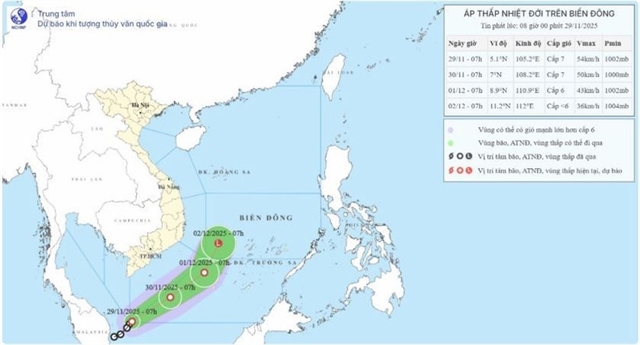 Economy
Economy

The Food & Beverage (F&B) market in Việt Nam is a vibrant and ever-changing industry, driven by shifting tastes, evolving customer demands and a constant need for innovation.
Customers who want to be indulged are presented with a plethora of choices. As a result, suppliers must remain adaptable, consistently innovate their offerings, locations and provide unique experiences to embrace emerging trends and entice new customers.
During an interview with Việt Nam News, Lại Tiến Mạnh, the CEO of Mibrand Vietnam and Lương Thuý Quyên, the General Manager of Brand Finance Vietnam, talked about the ever-changing trends within the coffee chain industry.
 |
| Lại Tiến Mạnh, the CEO of Mibrand Vietnam |
Major coffee chains like Highlands Coffee, Phúc Long, Starbucks, Katinat, etc., are tirelessly competing to dominate and increase their share of the market. How do you evaluate the competitive branding strategies of these coffee chains after the pandemic?
Lại Tiến Mạnh:
The recent period has witnessed a significant growth in the number of coffee chains, driven by several factors.
The COVID-19 pandemic has brought about notable changes in people's lifestyles and work habits. Remote working has become increasingly popular, with coffee shops emerging as preferred locations for work. Coffee businesses quickly recognised this trend and capitalised on the opportunity by developing products and spaces to cater to this customer group.
Decree 100, which restricts alcohol consumption, has led people to consume fewer alcoholic beverages and opt for cold drinks instead, making coffee shops an attractive choice.
Additionally, Việt Nam's F&B market itself is vibrant and possesses unique characteristics that favour the growth of coffee chains. Vietnamese people have diverse consumption habits when it comes to cafes. They visit cafes not only for work but also to meet friends, partners, colleagues, or even conduct livestreams on online sales platforms. Customers choose cafes based on their specific needs. Furthermore, coffee shops are conveniently located, concentrated in densely populated areas, office spaces and city centres, making them easily accessible.
Each coffee chain has its own strategy. For example, Highlands Coffee, being one of the largest brands in Việt Nam, has targeted the mid-range customer segment from the beginning. Their decor is not overly luxurious but provides a comfortable and elegant experience suitable for various settings, from formal work to casual conversations. With an extensive network and centrally located outlets, Highlands Coffee enjoys broad coverage. As a long-established chain, Highlands Coffee understands customers' preferences and needs. In addition to beverages and cakes, they also offer bánh mì, a popular Vietnamese fast food item, allowing customers to satisfy their hunger without having to visit another place. This sets them apart from other coffee chains that do not offer this product or have overly complicated food menus, resulting in fragmented and cumbersome service.
Trung Nguyên, on the other hand, is known for its unique coffee flavours and quality, catering to coffee enthusiasts and those who enjoy strong coffee profiles.
Katinat focuses on the young customer segment, offering aesthetically pleasing spaces that are perfect for taking pictures and sharing on social media, with coffee being a secondary focus for many customers.
 |
| Lương Thuý Quyên, the General Manager of Brand Finance Vietnam |
Lương Thuý Quyên:
Following the COVID-19 pandemic, the F&B market underwent a restructuring phase to ensure survival. Only brands that effectively seize opportunities can thrive as they did in the past. Each brand has a distinct strategic direction, targeting specific customer segments. Besides essential elements like good service, delicious drinks and appealing ambience, most café chains today strive to offer unique customer experiences by incorporating cultural elements that reinforce their brand's identity in the eyes of consumers. These factors and characteristics are currently the primary focus for most brands.
Different brands adopt different approaches. For instance, Highlands Coffee and Trung Nguyên leverage their understanding of Vietnamese coffee-drinking habits and the passion for coffee among Vietnamese people. This is evident in the restaurant's menu design and spatial layout. They leverage traditional ingredients into their menu offerings. Phúc Long is positioned for tea, Highland uses lotus seeds, Katinat adds traditional fruits. On the other hand, Katinat takes a slightly different path by enhancing customer experiences through a blend of classic and modern features in its restaurant design.
In 2023, several prominent coffee brands introduced completely unique models within their chain, positioning themselves as more upscale and distinct from other coffee shops. For example, Highlands unveiled their premium store, Highlands Bưu điện TP.HCM and The Coffee House launched SIGNATURE by The Coffee House. What motivates these coffee chains to introduce these new models?
Lại Tiến Mạnh:
These coffee chains have indeed adopted a smart strategy by targeting the mid-range customer segment, which represents a large customer base. However, they also recognise the importance of not missing out on the higher-end groups and their willingness to pay more for a premium experience. Introducing these high-end models helps solidify their position in the market, showcasing their unique and exceptional products and enticing customers to choose them.
This approach aligns with the psychology and preferences of Vietnamese people, who appreciate indulgence, quality service and a high-class experience. It also enhances the overall brand image, demonstrating that they can compete with any rival. Coffee chains do not build their brands through advertisements or influencer endorsements, as seen in other industries, but by focusing on services, facilities and providing an exceptional in-store experience. Customers expect more than just a delicious cup of coffee, they desire a comfortable and creative space with excellent service quality. The introduction of new high-end models caters to these needs more comprehensively.
Lương Thuý Quyên:
Café customers typically exhibit low loyalty, often switching between brands. When a new brand appears, they are inclined to try it out rather than displaying strong brand loyalty. Therefore, innovation plays a vital role in retaining existing customers, attracting new ones and outperforming competitors. The primary motivation for brands is to continuously innovate. They effectively leverage word-of-mouth advertising channels to bolster brand power. For example, Signature by The Coffee House targets coffee connoisseurs, offering them a novel customer experience. When something new emerges in the market, customers tend to spread the word, introducing it to others. This, in turn, drives usage.
Highlands Coffee's premium model, located near the HCM City Post Office, Saigon book street and Notre Dame Cathedral, capitalises on its prime position in one of Saigon's busiest areas frequented by both domestic and foreign tourists. This choice of location expands their reach and captures customers' attention. The design of this model exudes uniqueness and luxury, providing an exceptional customer experience. Additionally, this Highlands Coffee store utilises a modern roasting system and a visible coffee processing area, allowing customers to witness the coffee-making process firsthand. It is worth noting that all brands in the market are embracing eco-friendly practices. This particular Highlands store is the first to serve beverages in glass cups, rejecting the use of plastic cups and straws. As consumer awareness regarding sustainability increases, brands are inclined to adopt eco-friendly practices to improve their image.
In your opinion, do Vietnamese coffee brands have an advantage or face difficulties when competing with foreign brands in the market?
Lại Tiến Mạnh:
The F&B industry in Việt Nam is a dynamic market characterised by rapidly changing tastes, evolving needs and constant innovation. Customers seek to be pampered and have numerous options to choose from. This forces suppliers to be flexible, continuously innovate their products, processes and locations and create fresh experiences to capture new trends and attract new customers. Vietnamese coffee chains excel in this aspect, as they are highly responsive and attuned to their customers. They pay meticulous attention to product development, such as offering popular choices like salt coffee and cheese coffee. They also focus on the design of their shops, lighting, seating, table arrangements and restaurant layout to optimise the customer experience. These are areas where Vietnamese brands outperform foreign brands in the Vietnamese market.
Foreign brands like Starbucks, while prominent and occupying central positions, still have certain limitations compared to local Vietnamese brands. Their spaces are often more monotonous and their menus may lack the variety found in Vietnamese coffee chains. International chains often adhere to global processes and ways of working, which may not always align perfectly with Vietnamese preferences and expectations. Moreover, Vietnamese customers have a plethora of choices available to them. For instance, Starbucks' practice of writing customers' names on cups and calling out names loudly in a crowded environment is not always well-received by Vietnamese customers, who may find it uncomfortable. Starbucks may perceive this as customer-friendly, but it does not resonate as effectively in the Vietnamese context.
Lương Thuý Quyên:
The distinction between local and foreign brands does not significantly impact customer choices. In fact, local brands often possess an advantage over foreign chains. Local brands currently enjoy broader coverage with a greater number of stores compared to foreign brands. This extensive presence enhances brand awareness and enables them to reach a larger customer base. Additionally, local brands have a deep understanding of Vietnamese culture and cater to the taste preferences of Vietnamese people. They incorporate seasonal Vietnamese fruits into their menu offerings, which are highly popular among customers. On the other hand, foreign brands witness less frequent consumption due to lower coverage and higher prices. However, foreign brands typically follow a global, standardised model applied across all markets worldwide. Brand’s visibility at more countries will enhance brand power and brand value.
Some Vietnamese coffee chains are expanding internationally, such as Trung Nguyên planning to develop Trung Nguyên Legend coffee spaces in the US and China. In your view, what solutions do they need to compete with local brands in these markets?
Lại Tiến Mạnh:
Vietnamese coffee brands venturing abroad can learn from such lessons, emphasising the importance of market research and adapting to local preferences. It is crucial not to simply replicate the Vietnamese model abroad but instead carefully study the target market, understand customer preferences and respect their cultural nuances. In foreign countries, people have their own preferences and habits. Brands must also narrow their focus by selecting a specific target customer segment rather than attempting to cater to a broad range of customers.
Lương Thuý Quyên:
Expanding Vietnamese brands abroad is the aspiration of every brand. Once they achieve success in Việt Nam, they naturally desire to introduce their brand to the international stage. However, Vietnamese chains may encounter difficulties when venturing abroad due to the differences in customer preferences, styles and habits between Vietnamese and foreign customers. When going global, Vietnamese brands typically aim to showcase the culture, unique characteristics of their coffee products, and the coffee-drinking traditions of Việt Nam. While profit and business considerations are important, they are secondary to the goal of cultural promotion. But brands must also make adjustments to their menus to cater to the local preferences of customers without losing their inherent value. From a brand perspective, expanding into the global market allows for increased reputation and brand value worldwide. A successful business abroad enhances brand value. — VNS




